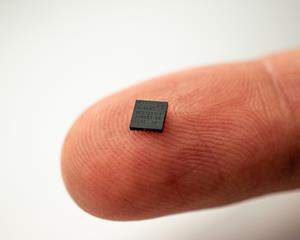LAS VEGAS, Jan. 07, 2020 (GLOBE NEWSWIRE) --
Boréas Technologies, developer of ultra-low-power haptic technologies for consumer and commercial products, today demonstrated at CES 2020® the BOS1211, the first low-power high-voltage piezoelectric driver integrated circuit (IC) to enable high-definition (HD) haptic feedback in automotive human machine interfaces (HMIs), such as automotive infotainment screens and safety alerts in touch-sensitive steering wheels.
Designed to support TDK’s family of 120V PowerHap™ piezo actuators — which lead the market in terms of acceleration, force and response time — Boréas’ BOS1211 is critical to satisfying growing demand for clear tactile feedback in automotive environments.
“Haptic feedback is as old as the human experience, which is why we find it so satisfying to know that an object responds to our touch,” said Simon Chaput, founder and CEO, Boréas Technologies. “The advent of the digital world has increased our need for haptic feedback, and that’s why we’re seeing multiple Tier 1 automotive manufacturers replacing buttons and touchpads with haptic-feedback touchscreens as well as top automotive suppliers embedding haptics into their new display products. Piezo haptic solutions from Boréas and TDK are uniquely positioned to give automotive manufacturers and suppliers what they want most: uncompromising performance, small size, enduring reliability, and unparalleled power efficiency.”
To meet the needs of the automotive market, Boréas is partnering with TDK, the world’s leading supplier of piezoelectric haptic actuators.
“Touch HMIs in cars are evolving with the times,” said Stefan Benkhof, head of product marketing of the TDK Piezo Business Unit. “From the knobs and buttons of one-hundred years ago to the flat screens that came to market over the last twenty years, clear and responsive haptics marks the next important interface advancement in automobiles. It’s companies like Boréas and TDK that are responsible for such advancements. We’re delighted that our combined technologies offer the clearest, most realistic and long-lasting piezo haptic solutions to our automotive customers around the world.”
Safer Driving through Piezo Haptics
Touch-based HMIs in cars are here to stay. More than 52.8 million automotive touch panels will be on the market by 2020, according to IHS Markit Center Stack Display Production Forecast, and that number is growing by 4.6% annually. At the same time, more drivers are using voice commands to make phone calls and send texts, and are receiving navigation instructions via audio. Although handsfree HMIs might sound like they’re safer for drivers, research from Stanford Universityi — which compared skin-stretch haptic feedback on the car’s steering wheel to auditory feedback for in-car navigation — concluded that drivers receiving haptic feedback responded better than those receiving audio feedback, and there’s a biological reason for that: Haptic feedback presents “a smaller cognitive load than the audio cues when driving while aurally or verbally distracted.”
A research study conducted by the United States Air Force and Arizona State Universityii concluded that drivers responded more effectively to tactile warnings, delivered via the gas pedal or the seat than to visual or auditory warnings when alerted to rear-end collisions. While research on whether tactile vs. auditory or visual stimuli leads to more distracted driving is ongoing, some researchers agree that the cognitive load on the human brain is less when that feedback is tactile.
Piezo Haptics at CES 2020
TDK will showcase its lineup of 120V PowerHap piezo haptic actuators during CES 2020, January 7-10, 2020 at the TDK booth (LVCC, Central Hall, # 11448). Boréas will help to drive TDK’s haptic actuators into automotive applications and is available for demonstrations by appointment only at the Boréas booth (LVCC, South Hall 4, #35824) — as well as at the TDK booth.
To schedule a meeting with Boréas, please email: sales@boreas.ca
About the BOS1211
The BOS1211 is a high-voltage low-power piezo driver IC that is based on Boréas’ patented
CapDrive™ technology, a proprietary scalable piezo driver architecture that provides the foundation for Boréas’ haptic chips. CapDrive delivers the advantages of piezoelectric material to the designer: greater energy efficiency, low heat dissipation and rapid response times, making CapDrive chips ideal for devices in which size, power, responsiveness and thermal management are essential. For more information, visit:
https://www.boreas.ca/pages/capdrive-technology
Availability
The BOS1211 is currently sampling to key customers. To speed design to production with the BOS1211 with TDK 120V PowerHap actuators, Boréas will offer a plug-and-play development kit for piezo haptic feedback in automotive and other applications that require high-force haptic feedback in February 2020. For more information, email:
info@boreas.ca
About Boréas Technologies
Boréas Technologies Inc. is a fabless semiconductor company commercializing product-differentiating piezo driver ICs for piezo actuators used in consumer, automotive and industrial markets. With origins in research conducted at Harvard University, Boréas was founded in 2016 in Bromont, Québec. Its proprietary CapDrive technology platform — on which the company’s driver ICs are based — is ideal for resource-constrained devices such as smartphones, game controllers, wearables and Internet of Things (IoT) devices.
Stay in touch with Boréas on LinkedIn, YouTube or visit us online: https://www.boreas.ca
The Boréas logo is a registered trademark, and CapDrive is a trademark of Boréas Technologies Inc. All other product and company names are trademarks or registered trademarks of their respective holders.
Press Contacts
Nicolas Duchesne-Laforest, Boréas Technologies
Email:
nduchesnelaforest@boreas.ca
Maria Vetrano, Vetrano Communications
Email:
maria@vetrano.com
A photo accompanying this announcement is available at https://www.globenewswire.com/NewsRoom/AttachmentNg/64c1380e-025b-4e0b-8cba-c714e4bc780a
____________________
i Ploch, C.J., Bae, J.H., Ploch, C.C., Ju, W., Cutkosky, M.R., "Comparing Haptic and Audio Navigation Cues on the Road for Distracted Drivers with a Skin Stretch Steering Wheel," In proceedings of the 2017 IEEE World Haptics Conference (WHC 2017).
ii Scott, J. J.; Gray, Robert. “A Comparison of Tactile, Visual, and Auditory Warnings for Rear-end Collision Prevention in Simulated Driving,” In: Human Factors, Vol. 50, No. 2, 04.2008, p. 264-275 J. J. Scott, United States Air Force, Edwards Air Force Base, California, and Robert Gray, Arizona State University, Mesa, Arizona









